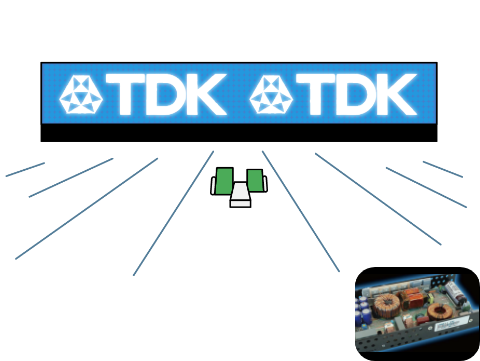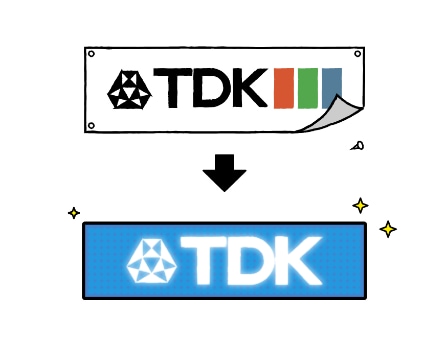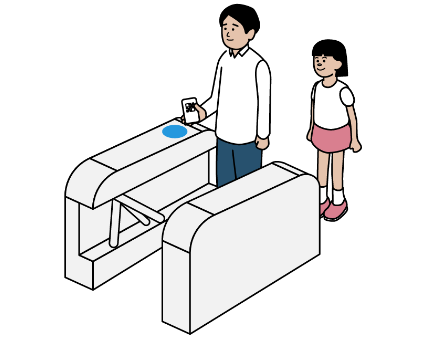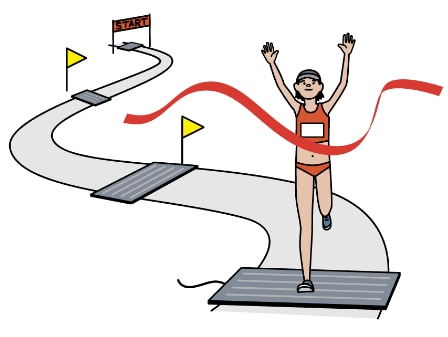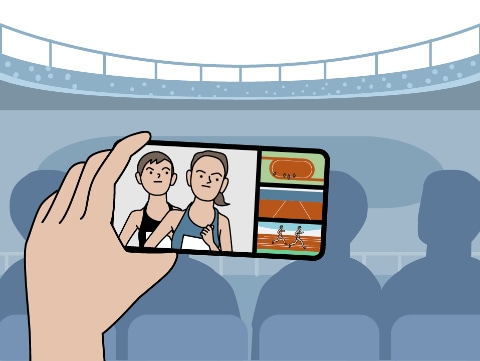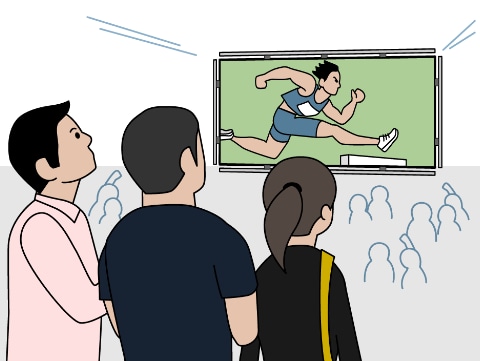World Athletics Championships Trivia
TDK has been supporting the World Athletics Championships as a bib sponsor ever since the first tournament in Helsinki in 1983. On this page we introduce various episodes showing, among other things, TDK’s involvement in the championships and how the championships have been changed by technology from 1983 to the present.
TDK signboard appeared after some unexpected trouble
It can be said that the highpoint of track and field competition is the 100 meter race. The massive board with an impressive TDK logo behind the start line made its first appearance at the second Championships in Rome in 1987. In fact, the board was installed in a rush while the Championships were already underway. During the event, an incident occurred when one athlete removed the number bib with the TDK logo. In response to this incident, following discussions with the sponsoring organization at the time, it was decided that TDK would install a board with its logo the following day. For nearly 40 years, this massive TDK board, which first appeared as a result of an unexpected problem, has watched over the athletes who attract attention worldwide by taking on the 100 meter race.
Behind-the-scenes support from TDK technology
for the shining LED board
The 100 m start board installed in Hayward Field, the venue for the 18th Championships in Oregon, is an LED board that uses TDK products called AC-DC converters (AC input power supplies). TDK’s AC-DC converters are used in large display devices installed at athletics fields, baseball stadiums, soccer stadiums, and many other venues around the world. To display images, electricity is converted from alternating current (AC) to direct current (DC) within the device and converted to the proper voltage for accurately displaying the red, green, and blue (RGB) colors of the image. Be sure to keep an eye out for an LED board that uses TDK power supply technology.
Start board evolves brilliantly
from printing to LED
The 100 m start board made its debut during the Roman Championships in 1987. The TDK logo displayed on that board was created through color printing. Since the World Athletics Championships Beijing in 2015, an LED board had been used, and since the World Athletics Championships Oregon22, a 100 m LED board supported by TDK power supplies has been used.
Admission also evolves smartly
with electronic tickets
For many years, paper tickets were issued. What changed this was the two-dimensional barcode-based electronic ticket, which appeared in the 2000s. As a result, spectators are able to enter the venue by printing an email or by showing a display on a mobile phone (feature phone). Around 2010, rapid advances in smartphones were made, and electronic tickets using special-purpose apps became the norm. Electronic tickets will be introduced at the World Athletics Championships Oregon22.
Mechanical eye does not miss differences of
even 1/1000 of a second
Running times are measured during the 100 meter race, where a difference of one one-hundredth of a second can be decisive. In the past, timer personnel use stopwatches to measure times, but at the 1964 Tokyo Olympics, a photographic judging system was introduced for the first time as a method of race finish order other than by eye. At the World Athletics Championships, a photographic judging system has been used since the first games in Helsinki, and now slit video which can capture thousands of images per second and infrared rays are used to measure the finish order and times.
Times can be measured as runners pass.
What is this marathon timing technology?
Until the 1980s, measurements of time and finish order were determined by reading the barcodes printed on athlete number bibs at the finish line. In the early 1990s, a system that performs measurement using a transponder (IC tag) attached to the bib or shoes was developed. This system requires much less manpower, time measurements are substantially more accurate, and split time and other measurements are also possible, making this a ground-braking advance. The barcode system was used for between the first World Athletics Championships in Helsinki and the sixth World Athletics Championships in Athens, and a transponder system was introduced at the Seville Championships in 1999.
Could viewing styles change with multi-angle images?
Until the 1990s, spectators at competition venues could access media using a portable radio or portable television. However, this form of spectatorship did not become popular due to unstable communications conditions and the inconvenience of carrying devices. In the early 2000s, mobile phones (feature phones) were equipped with digital audio and video data reception functions, but even this did not become common as a means of viewing competitions. With the spread of smart phones and the appearance of 5G, however, competitions can now be watched in a completely different way. Multi-angle functionality using 5G enables users to enjoy the competition from multiple angles in near real time on their smartphones while watching from their seats in the stands. Demonstration trials are currently underway, and this technology is attracting attention as a new method of viewing at the World Athletics Championships.
Technology evolving to raise the spirits of everyone together
Until recently, sports broadcasts including the World Athletics Championships were generally watched at home on TV or in some restaurants and bars. Public viewing, which has become popular since the 2000s, makes it possible to feel the excitement of sports with a large group of people. Setting up a large screen in a stadium or other location and watching the sport with a large number of people makes it possible to feel as if one is at the actual venue. More recently, enjoying sports competitions with many others through social media is also becoming popular. Some people enjoy monitoring others’ social media streams to hear their excited commentary and analysis during the game and want to watch games with a large number of people. Watching the event on social media, both at the venue and other locations, will continue to provide new ways of enjoying sports in the future.
There have been many renowned competitions in the World Athletics Championships including new world records. There have also been many interesting episodes as well as technological advancements in the background to these great competitions. TDK will continue support athletes from around the world who challenge their limits.


